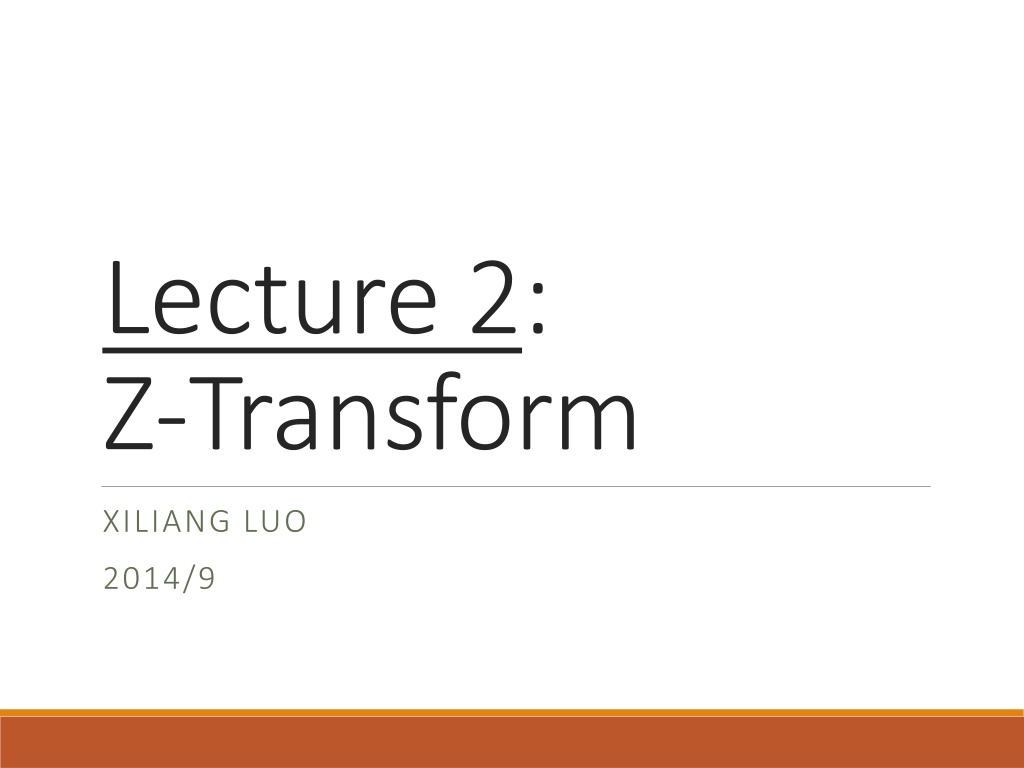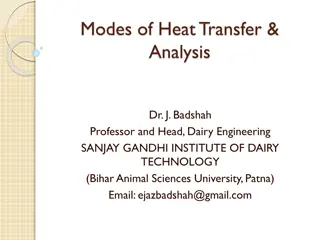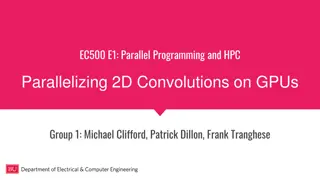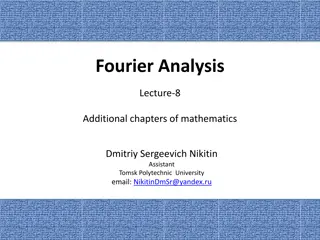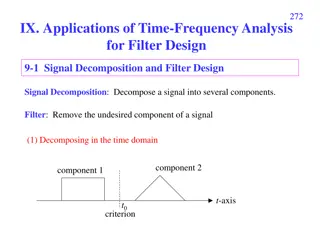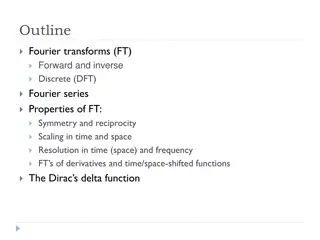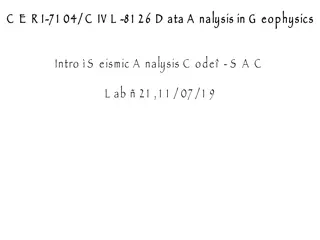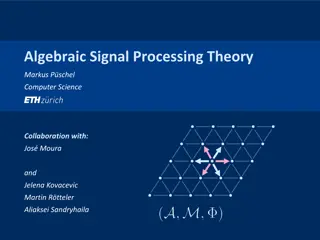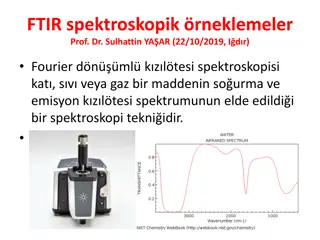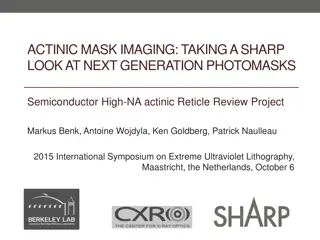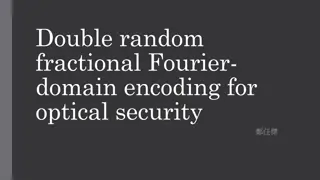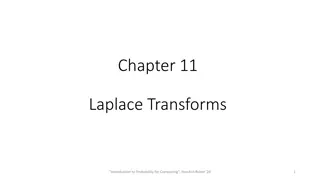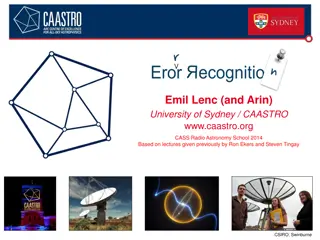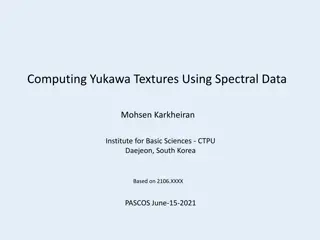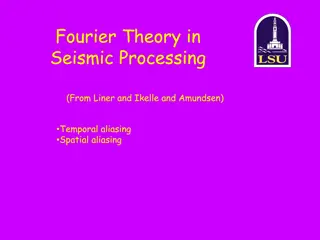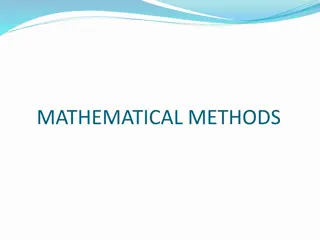Z-Transform and Fourier Transform Insights
Delve into the world of Z-Transform and Fourier Transform, exploring convergence, square summable sequences, complex Z-plane, region of convergence, and more. Understand the distinction between right-sided and left-sided exponential sequences and their shared properties in Z-Transforms.
Download Presentation

Please find below an Image/Link to download the presentation.
The content on the website is provided AS IS for your information and personal use only. It may not be sold, licensed, or shared on other websites without obtaining consent from the author.If you encounter any issues during the download, it is possible that the publisher has removed the file from their server.
You are allowed to download the files provided on this website for personal or commercial use, subject to the condition that they are used lawfully. All files are the property of their respective owners.
The content on the website is provided AS IS for your information and personal use only. It may not be sold, licensed, or shared on other websites without obtaining consent from the author.
E N D
Presentation Transcript
Lecture 2: Z-Transform XILIANG LUO 2014/9
Convergence A sufficient condition: absolutely summable it can be shown the DTFT of absolutely summable sequence converge uniformly to a continuous function
Square Summable A sequence is square summable if: ?[?]2< ?= For square summable sequence, we have mean-square convergence:
Z-Transform a function of the complex variable: z If we replace the complex variable z by ???, we have the Fourier Transform!
Z-Transform & Fourier Transform
Region of Convergence The set of z for which the z-transform converges is called ROC of the z- transform. Absolutely summable criterion:
ROC ROC consists of a ring in the z-plane
Closed-Form in ROC When X(z) is a rational function inside ROC, i.e. P(z), Q(z) are polynomials in z Zeros: values of z such that X(z) = 0 Poles: values of z such that X(z) = infinity
Z-Transform Example: Right-Sided
Z-Transform Example: Left-Sided
Diff. Sum, Same Z-Transform? One is right-sided exponential sequence One is left-sided exponential sequence But they share the same algebraic expressions for their Z-Transforms This emphasizes the importance of the region of convergence!!
Inverse z-Transform From the z-Transform, we can recover the original sequence using the following complex contour integral: 1 ? ? ?? 1?? 2?? ? ? = ? C is a closed contour within the ROC of the z-transform
Inverse z-Transform Methods Inspection familiar with the common transform pairs Partial Fraction Expansion Power Series Expansion
z-Transform Properties 1. Linearity 2. Time Shifting 3. Multiplication by an Exponential Sequence
z-Transform Properties 4. Differentiation of X(z) 5. Conjugation of a Complex Sequence 7. Time Reversal
z-Transform Properties 7. Convolution of Sequences
z-Transform and LTI Systems LTI system is characterized by its impulse response h[n] y[n] x[n] h[n] ? ? = ? ? [?] ? ? = ? ? ?(?) H(z) is called the system function of this LTI system!
Cauchy-Riemann Equations If function f(z) is differentiable at z0=x0+y0, then its component functions must satisfy the following conditions: ? ? = ? ?,? + ??(?,?) ?? ??=?? ?? ?? ??= ?? ??
Analytic Functions A function f(z) is analytic at a point z0 if it has a derivative at each point in some neighborhood of z0. So, If f(z) is analytic at a point z0, it must be analytic at each point in some neighborhood of z0.
Taylor Series Theorem: Suppose that a function f is analytic throughout a disk: |z- z0|<R0, centered at z0 and with radius R0, then f(z) has the power series representation: + ? ? ?0 < ?0 ? ? = ??? ?0 ?=0 ??=??(?0) ?!
Laurent Series If a function is not analytic at a point z0, one cannot apply Taylor s theorem at that point! Laurent s Theorem: Suppose a function f is analytic throughout an annular domain centered at z0: ?1< ? ?0 < ?2 Let C denote any positively oriented simple closed contour around z0 and lying in the domain, then, at each point in the domain, f(z) has the series representation: + ? ? ? = ??? ?0 ?=
Laurent Series + ? ? ? = ??? ?0 ?= 1 ? ? ?? ? ?0 ??= 2?? ?+1 ?
Homework Problems 3.52: 3.56: 3.57: 3.59:
Next Sampling of Continuous-Time Signals Please read the textbook Chapter 4 in advance!
